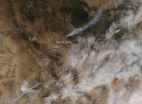(Press-News.org) BERKELEY — California's winter tule fog -- hated by drivers, but needed by fruit and nut trees -- has declined dramatically over the past three decades, raising a red flag for the state's multibillion dollar agricultural industry, according to researchers at the University of California, Berkeley.
Crops such as almonds, pistachios, cherries, apricots and peaches go through a necessary winter dormant period brought on and maintained by colder temperatures. Tule fog, a thick ground fog that descends upon the state's Central Valley between late fall and early spring, helps contribute to this winter chill.
"The trees need this dormant time to rest so that they can later develop buds, flowers and fruit during the growing season," said biometeorologist and study lead author Dennis Baldocchi, whose father grew almonds and walnuts in Antioch and Oakley. "An insufficient rest period impairs the ability of farmers to achieve high quality fruit yields."
The study was posted online May 15 in the journal Geophysical Research Letters, a publication of the American Geophysical Union. The findings have implications for the entire country since many of these California crops account for 95 percent of U.S. production, the authors noted.
The researchers paired NASA and National Oceanic and Atmospheric Administration satellite records with data from a network of University of California weather stations, covering 32 consecutive winters. There was a great deal of variability from year to year, but on average, the researchers found a 46 percent drop in the number of fog days between the first of November and the end of February.
"The year-to-year variability we saw was likely influenced by whether the season was relatively wet or dry," said Baldocchi, professor in UC Berkeley's Department of Environmental Science, Policy and Management. "Generally, when conditions are too dry or too wet, we get less fog. If we're in a drought, there isn't enough moisture to condense in the air. During wet years, we need the rain to stop so that the fog can form."
Other studies have marked the decline in the Central Valley of winter chill – the number of hours between 0 and 7 degrees Celsius. The number of hours of winter chill has dropped by several hundred since the 1950s, the study authors noted.
But ambient air temperature alone may not adequately reflect the heat experienced by the crops, said Baldocchi. Direct sunlight can heat the buds so that they are warmer than the surrounding air temperature. As a result, fog is important in shielding the buds from the sun and helping them accumulate winter chill.
Climate forecasts suggest that the accumulation of winter chill will continue to decrease in the Central Valley. Baldocchi said that fruit developers are already trying to develop cultivars that can tolerate less winter chill.
"Farmers may also need to consider adjusting the location of orchards to follow the fog, so to speak," said Baldocchi. "Some regions along the foothills of the Sierra are candidates, for instance. That type of change is a slow and difficult process, so we need to start thinking about this now."
INFORMATION:
The study was co-authored by Eric Waller, a UC Berkeley Ph.D. student in the Department of Environmental Science, Policy and Management.
The California Energy Commission supported this research.
Central Valley sees big drop in wintertime fog needed for fruit and nut crops
2014-05-20
ELSE PRESS RELEASES FROM THIS DATE:
New analysis eliminates a potential speed bump in quantum computing
2014-05-20
A quantum particle can search for an item in an unsorted "database" by
jumping from one item to another in superposition, and it does so
faster than a classical computer ever could.
This assertion assumes, however, that the particle can directly hop from any item to any other. Any restriction on which items the particle can directly hop to could slow down the search.
"Intuition says that a symmetric database allows the particle to hop freely enough to retain the quantum speedup, but our research has shown this intuition to be false," says Tom Wong, a physicist at ...
Penn team identifies promising new target for gum disease treatment
2014-05-20
Nearly half of all adults in the United States suffer from the gum disease periodontitis, and 8.5 percent have a severe form that can raise the risk of heart disease, diabetes, arthritis and pregnancy complications.
University of Pennsylvania researchers have been searching for ways to prevent, half and reverse periodontitis. In a report published in the Journal of Immunology, they describe a promising new target: a component of the immune system called complement. Treating monkeys with a complement inhibitor successfully prevented the inflammation and bone loss that ...
A full serving of protein at each meal needed for maximum muscle health
2014-05-20
Most Americans eat a diet that consists of little to no protein for breakfast, a bit of protein at lunch and an overabundance of protein at dinner. As long as they get their recommended dietary allowance of about 60 grams, it's all good, right?
Not according to new research from a team of scientists led by muscle metabolism expert Doug Paddon-Jones of the University of Texas Medical Branch at Galveston. This research shows that the typical cereal or carbohydrate-dominated breakfast, a sandwich or salad at lunch and overly large serving of meat/protein for dinner may not ...
Cognitive test can differentiate between Alzheimer's and normal aging
2014-05-20
CHAMPAIGN, Ill. — Researchers have developed a new cognitive test that can better determine whether memory impairments are due to very mild Alzheimer's disease or the normal aging process.
Their study appears in the journal Neuropsychologia.
The Alzheimer's Association estimates that the number of Americans living with Alzheimer's disease will increase from 5 million in 2014 to as many as 16 million by 2050. Memory impairments and other early symptoms of Alzheimer's are often difficult to differentiate from the effects of normal aging, making it hard for doctors to ...
School-based interventions could benefit children from military families
2014-05-20
COLUMBIA, Mo. – Nearly 2 million children in the United States have experienced a parent's military deployment. Previous research has shown that these children may be at increased risk for emotional, behavioral and relationship difficulties, yet little is known about how best to address military children's specialized needs. Now, an MU researcher says school-based interventions could benefit children whose parents have deployed.
David Albright, an assistant professor at the MU School of Social Work, says military children are an overlooked population in need ...
Unlocking the potential of bacterial gene clusters to discover new antibiotics
2014-05-20
Resistance to antibiotics has been steadily rising, posing a threat to public health. Now, a method from Mohammad Seyedsayamdost, an assistant professor of chemistry at Princeton University, may open the door to the discovery of a host of potential drug candidates.
The vast majority of anti-infectives on the market today are bacterial natural products, made by biosynthetic gene clusters. Genome sequencing of bacteria has revealed that these active gene clusters are outnumbered approximately ten times by so-called silent gene clusters.
"Turning these clusters on would ...
Receptive to music
2014-05-20
This news release is available in German. Music can be soothing or stirring, it can make us dance or make us sad. Blood pressure, heartbeat, respiration and even body temperature – music affects the body in a variety of ways. It triggers especially powerful physical reactions in pregnant women. Scientists at the Max Planck Institute for Human Cognitive and Brain Sciences in Leipzig have discovered that pregnant women compared to their non-pregnant counterparts rate music as more intensely pleasant and unpleasant, associated with greater changes in blood pressure. Music ...
Update for Skunk Fire, Arizona
2014-05-20
The Skunk Fire which began as a lightning strike on Saturday, April 19 is currently 31,167 acres large including fire growth and back burns.The fire continues to move in a north westerly direction and an easterly direction towards ponderosa pine forest. South and North side of the fire is contained. The terrain for this fire is steep with scattered boulders making firefighting more difficult. The entire fire is currently 44% contained and full containment is expected by Friday, May 23, according to Inciweb.org.
The National Weather Service has forecast maximum temperatures ...
Boosting Immune process with IFN-γ helps clear lethal bacteria in cystic fibrosis
2014-05-20
Boosting a key immune process called autophagy with interferon gamma (IFN-γ) could help clear a lethal bacterial infection in cystic fibrosis, a new study suggests. The work, led by a team in The Research Institute at Nationwide Children's Hospital and published in PLoS One in May, offers new information about immune function in patients with the disease.
Cystic fibrosis, CF for short, is caused by a malfunction in the CFTR gene, which is responsible for transporting chloride and water across cell membranes. In people with the disease, cells that line the passageways ...
Scientists study biomechanics behind amazing ant strength
2014-05-20
A recent study into the biomechanics of the necks of ants – a common insect that can amazingly lift objects many times heavier than its own body – might unlock one of nature's little mysteries and, quite possibly, open the door to advancements in robotic engineering.
A small group of engineers at The Ohio State University combined laboratory testing and computational modeling conducted at the Ohio Supercomputer Center to determine the relationship between the mechanical function, structural design and material properties of the Allegheny mound ant (Formica exsectoides). ...






